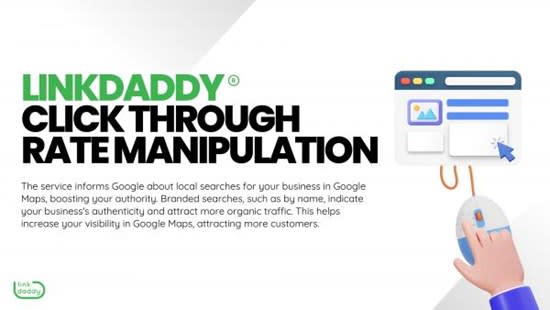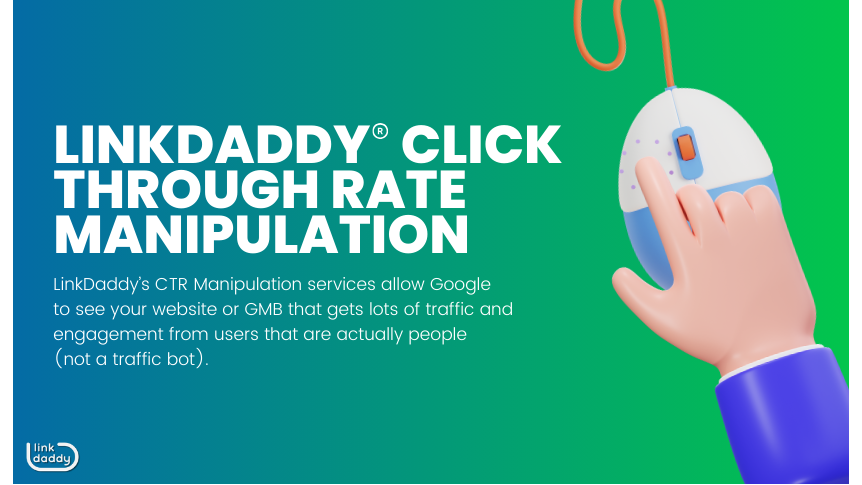LinkDaddy CTR Manipulation Explained: What You Need to Know for SEO
Wiki Article
CTR Adjustment Techniques to Boost Your Conversion Rates
Efficient CTR adjustment techniques can significantly impact the success of your electronic marketing efforts. From crafting attracting meta titles to purposefully putting call-to-action buttons, tiny changes can produce substantial enhancements in conversion prices. By understanding the nuances of customer actions and carrying out data-driven techniques, marketing experts can open the potential for enhanced involvement and consumer acquisition. However what are the certain methods that can boost your CTR game and drive conversions to brand-new elevations? Let's discover the vital methods that can change your project efficiency and thrust your organization towards success.Understanding CTR and Its Effect
The Click-Through Rate (CTR) is a vital statistics in on-line advertising and marketing projects, indicating the portion of individuals who click a particular link contrasted to the overall number of impressions. CTR Manipulation Service. CTR is a vital performance sign used to determine the effectiveness of electronic advertising and marketing initiatives, particularly in pay-per-click (PPC) advertising and marketing. A high CTR suggests that the ad duplicate, key words, and targeting are reverberating well with the target audience, causing enhanced traffic and potentially greater conversion rates. On the other hand, a low CTR may show that the project requires optimization or that the messaging is not engaging enough to lure individuals to click via.Comprehending CTR and its effect is necessary for marketers to make informed decisions regarding their online advertising methods. By keeping track of and assessing CTR data, online marketers can recognize fads, adjust their projects in real-time, and improve overall performance. Inevitably, a deep understanding of CTR equips online marketers to produce much more effective and appealing campaigns that drive meaningful results.

Crafting Engaging Meta Titles
Crafting engaging meta titles is a basic element of enhancing web content for online search engine and customer interaction. A well-crafted meta title works as the initial factor of call in between your web content and the online search engine individual. It ought to be concise, appropriate, and tempting, supplying a glimpse of what the page needs to use. When producing meta titles, it's important to consist of relevant keywords that line up with the material on the page to improve internet search engine presence. In addition, including power words or psychological triggers can help catch the user's attention and urge click-throughs.To craft compelling meta titles, take into consideration the personality limitation imposed by internet search engine to make sure that the title displays successfully in search engine result. Go for a title that precisely summarizes the material while igniting the user's interest for more information. Checking different variations and examining efficiency metrics can aid figure out which meta titles reverberate best with your target audience. Ultimately, spending effort and time into producing exciting meta titles can dramatically impact click-through prices and overall site presence.
Using Abundant Snippets for Visibility
To enhance on the internet exposure and draw in even more organic traffic, site owners can leverage rich snippets tactically (LinkDaddy CTR Manipulation). Rich snippets give customers with even more details about a webpage straight on the internet search engine results web page (SERP) By integrating structured information markup into their site's HTML, companies can highlight essential details like reviews, rankings, prices, and product availability. This added details not only makes the search results more useful but additionally raises the opportunities of individuals clicking via to the website.Carrying out abundant fragments can enhance click-through rates (CTRs) by making the search providing more relevant and attractive to users' questions. Abundant fragments can boost the overall customer experience by supplying quick understandings right into the web content of the webpage before users even visit it.
Optimizing Call-to-Action Buttons

The layout of the switch, including its shade, message, size, and shape, can have a considerable effect on customer habits. A different shade that stands apart on the page, a size that is neither too small neither as well big, and concise yet persuasive text can all add to greater click-through rates. Furthermore, the positioning of the call-to-action button on the web page is crucial. It should be purposefully advice placed where it is accessible and conveniently obvious to individuals without being invasive. By continuously checking and refining these elements, internet site owners can optimize their call-to-action buttons to improve conversion rates successfully.
Studying and Testing Methods
Connecting information evaluation and testing is a crucial step in fine-tuning the effectiveness of call-to-action buttons for site optimization. By evaluating user habits, click-through prices, and conversion metrics, businesses can get useful understandings into what resonates with their target market. A data-driven method enables educated decision-making when checking various techniques to improve CTR.A/B testing is a typical technique used to contrast two versions of a page to determine which one carries out much better. By systematically changing one element at a time, such as the color, dimension, or wording of a CTA button, businesses can track the influence on customer involvement and conversion rates. This repetitive process of screening and evaluating outcomes makes it possible for businesses to make data-backed choices on maximizing their call-to-action buttons for optimal influence.
In addition, heatmaps and customer recordings supply aesthetic depictions of individual communications on a web page (CTR Manipulation Service). This qualitative data can uncover use problems, locations of rate of interest, and individual actions patterns, directing organizations in fine-tuning their CTA methods. By integrating measurable evaluation with qualitative insights, businesses can continually iterate and boost their CTR adjustment methods to drive higher conversion prices
Verdict
In final thought, applying CTR control techniques such as crafting compelling meta titles, using rich snippets, optimizing call-to-action buttons, and assessing performance metrics can substantially improve conversion rates in digital advertising and marketing campaigns. By strategically enhancing various components and constantly testing and changing techniques based upon data-driven understandings, marketing professionals can properly convert site site visitors right into faithful consumers.The Click-Through Rate (CTR) is an important statistics in on the internet advertising campaigns, suggesting the portion of customers who click on a details link contrasted to the complete number of impressions. On the other hand, a low CTR might indicate that the project needs optimization or that the messaging is link not involving enough to lure individuals to click through.
Carrying out rich fragments can improve click-through rates (CTRs) by making the search noting extra attractive and pertinent to individuals' inquiries. Rich snippets can improve the overall user experience by giving quick understandings into the content of the page before customers also see it.Furthermore, heatmaps and individual recordings provide visual representations of customer interactions on a page.
Report this wiki page